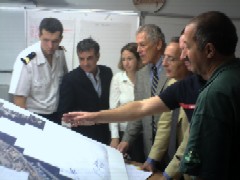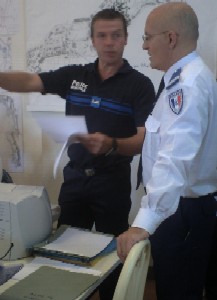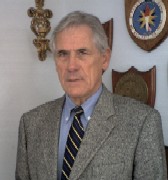 08:44 AM: the second engineer of the ship “Dream of the Seas” makes a false maneuver and accidentally drains a tank of oily water into the bay off Villefranche-sur-Mer. The tar slick is noticed by a pleasure boater. It threatens the shoreline. A coordinated action is mandatory.
08:44 AM: the second engineer of the ship “Dream of the Seas” makes a false maneuver and accidentally drains a tank of oily water into the bay off Villefranche-sur-Mer. The tar slick is noticed by a pleasure boater. It threatens the shoreline. A coordinated action is mandatory.
This is just a scenario. As part of the infra-POLMAR plan, the fictional exercise allows the municipal crisis unit, activated for this purpose, to manage a crisis strategically and thus address the “technological risks” aspect of the “municipal safeguard plans.” It aims to instill a “risk culture” to remind that an ecological disaster here is possible. Training municipal personnel will help them not to panic in case of pollution and to know who does what and what each person should do. A year ago, the beaches of Beaulieu-sur-Mer and Saint-Jean-Cap-Ferrat experienced coastal pollution due to an accidental discharge.
The Communal POLMAR Correspondent (CPC), informed by the municipal police, notifies the mayor. And the crisis unit is then set up. Initial decisions: inform the CPCs of neighboring municipalities, the Prefecture, the SDIS, the gendarmerie, FORCE06, the CANCA, the CCI which manages the port, the DDE, the General Council and the Regional Council.

All these institutions will have to provide all the necessary assistance and remain attentive to the affected municipality throughout the duration of the crisis. All this remains protocol. The exercise is laborious. The CPCs have received training. The other actors have not. We are fumbling, questioning. The fictional crisis unit around Ms. Hattenberg, playing the role of the Mayor, tries to consider all the elements. “We take the municipal decree 47-48.” It corresponds to triggering the infra-POLMAR plan. We call a bailiff to verify the cleanliness of the beaches. Then comes the question of media communication of the information. All the media or only the radio to relay the information to as many people as possible immediately. We seek to contact all those who work at sea or with seawater. The technical services will have to prohibit access to the beaches at risk of being contaminated. We assess human and material needs.
“This kind of exercise is important for the coastal municipalities of the Urban Community. We test the procedures. It is necessary to help them understand this problem. 100 oil tankers pass offshore. There are also discharge operations. For three years, the CEDRE has been training CPCs on marine pollution. They even went to Brest to learn crisis management,” explains Marc Lafaurie, vice-president of the Nice Côte d’Azur Urban Community in charge of the Environment. During the fictional scenario, Marc Lafaurie is in a second room representing the external crisis unit to the municipality where all the participants who will be called by the municipality during the exercise are present. “It is good. We can better coordinate because, in reality, we will not be in the same room. We are getting to know each other,” confides Mr. Lafaurie. This unit organizes better. The people present, including Arnaud Guena from CEDRE (Centre for Documentation, Research and Experimentations on Accidental Water Pollution), who came especially from Brest, are more used to handling this kind of crisis. The method is reliable and the interventions are methodical.
From this exercise, decided by the CANCA and for which the Commune of Villefranche-sur-Mer volunteered, we will remember the complexity of implementing an alert. Faced with it, the simulation seems indispensable in case the fictional becomes real.



